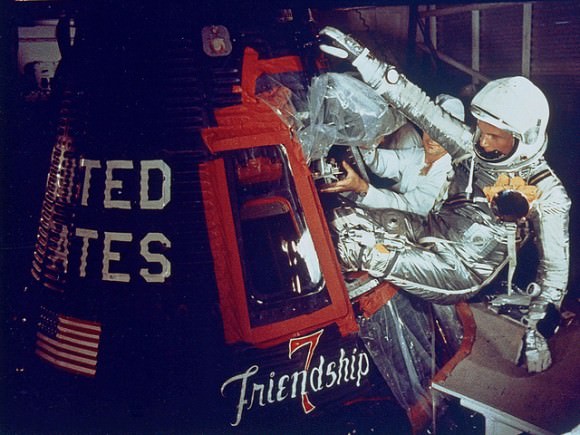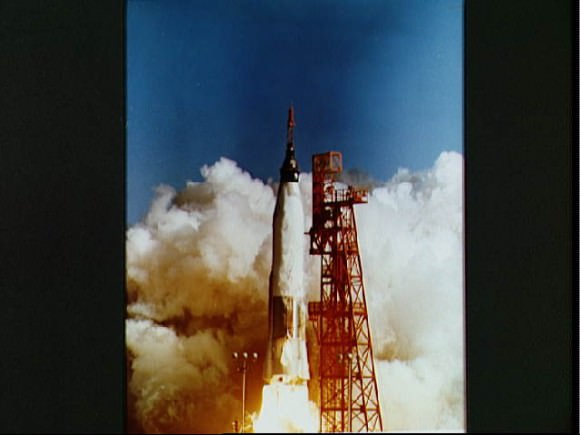We’ll be the first to admit that the 1983 movie The Right Stuff takes artistic license when it talks about the Mercury program and other events. It exaggerates problems between the astronauts, portrays the journalists as unthinking buffoons and misrepresents historical events such as breaking the speed of sound.
Late in the three-hour film, the movie turns to astronaut John Glenn‘s first flight in space, which took place on this day in 1962. Glenn was the first American to make an orbital flight of the Earth. He returned a national hero.
Below we’ll highlight a few points of similarity and difference between the movie and John Glenn’s own account of the flight of Friendship 7, which he detailed in his 1999 biography John Glenn: A Memoir. And yes, the rest of this post does contain spoilers for those who haven’t seen the film.
– Visit from Lyndon Johnson. During an aborted launch attempt, the movie shows Lyndon Johnson parked nearby the Glenns’ house in a limousine, ordering an aide to let him inside. Glenn’s wife Annie (through a fellow astronaut wife) keeps informing the hapless assistant that there’s no way Johnson (and the TV cameras he wants to include) can come in. While Glenn’s actual account doesn’t specify where the vice-president of the United States was at that time, he does talk about the request and refusal. “She said she was tired, she had a headache, and she just wasn’t going to allow all those people in her house … I told her whatever she wanted to do, I would back her up 100 percent.”
– Threat to remove Glenn from the flight. In The Right Stuff, Glenn then gets into a shouting argument with a NASA official nearby, who orders him to get on the phone and tell Annie to let the vice-president in. The NASA official threatens to replace Glenn with another astronaut, at which point Glenn’s colleagues surround him and the official backs down. Glenn confirms the incident, but does not mention other astronauts: “I saw red. I said that if they wanted to do that, they’d have a press conference to announce their decision and I’d have one to announce mine, and if they wanted to talk about it anymore, they’d have to wait until I took a shower. When I came back, they were gone and I never heard any more about it.”

– Fireflies. An extended sequence in The Right Stuff shows Glenn exclaiming as he sees “fireflies” outside of the spacecraft. The movie doesn’t really explain why they happen, but yes, they actually were there. “I saw around the capsule a huge field of particles that looked like tiny yellow stars,” Glenn wrote in his memoir. “They seemed to travel with the capsule, but more slowly. There were thousands of them, like swirling fireflies.” Glenn added: “They were droplets of frozen water vapor from the capsule’s heat exchanger system, but their fireflylike glow remains a mystery.” However, fellow astronaut Scott Carpenter noted frost flakes from his spacecraft, Aurora 7 on the next Mercury flight after Glenn’s, and floating nearby. They shone when the Sun illuminated the flakes. He also noticed more flakes coming off the side of his spacecraft when he banged the inside.
– Activities in orbit. While allowing that The Right Stuff probably had other priorities in mind, the movie does not show Glenn doing much in orbit besides gazing out the window and talking about the aforementioned fireflies. Glenn’s book shows him doing more than that: taking his blood pressure, snapping pictures of the Canaries and Sahara Desert, testing his vision, and doing exercises with a bungee cord to compare his readings to previous ones taken on the ground.
– Lights on in Perth and Rockingham, Australia. Glenn and a ground station in Australia chat about the residents of Rockingham and Perth turning on their lights for him. This actually did happen (and it happened again when Glenn returned to space in 1998.)
– Decision to bring Glenn down after three orbits. The movie accurately says Glenn was go for at least seven orbits, but then shows Glenn being confused when he’s told to come down after only three. Glenn contradicts that directly in his account: “The mission was planned for three orbits, but it meant that I could go for at least seven if I had to.”

– Heat shield threat. The movie shows Mission Control grappling with a signal indication that the landing bag deployed, which implies that the heat shield might have cut loose prematurely. They recommend Glenn refrain from removing a retrorocket package that usually was jettisoned after the rockets fire for re-entry, and keep it on the spacecraft to hold the heat shield on. Glenn talks at length about the situation in his book, and expresses frustration that he didn’t receive information quickly: “I was irritated by the cat-and-mouse game they were playing with the information.” It turned out to be a false alarm.
– Humming. Glenn hums a lot in the movie during the re-entry, especially as the gravity forces build up on him. The astronaut makes no mention of doing so in his book. Long-standing New York Times space journalist John Noble Wilford unequivocally stated the movie was wrong: “Mr. Glenn did not hum ”The Battle Hymn of the Republic” during re-entry,” he wrote in a 1983 review of the movie.


During the heat shield incident, flight director Chris Kraft was overridden by higher-ups in the decision to keep the retrorocket package attached. This directly led to the policy thereafter that the flight director had full and final authority in all decisions involving mission success and astronaut safety.
The “at least seven orbits” issue surely is the grassy knoll
of American spaceflight history. That radio call meant the spacecraft had
achieved an orbit that would last that long without decaying naturally. Glenn
was not confused by any decision to end the flight after three orbits. There
was never any possibility of the flight lasting longer than three orbits.
Never, ever, ever, ever, ever. Never!
Well the movie was necessarily a condensation of the book by the same name. Because of this shorthand interpretation of some of the trepidations noted and historical events already “improved upon” for dramatic purposes by Tom Wolfe’s writing style its pretty amazing they got so much right. I have yet to see an historical movie that gets every ‘jot and tittle’ in exactly the right place no matter how well they try.
Although I enjoyed The Right Stuff, I enjoyed From the Earth to the Moon much more and have watched it several times since I bought it on DVD. In fact I have been watching it this week. 🙂
Interesting that Scott Carpenter noticed flakes coming off the side of his spacecraft when he banged the inside! As a kid in elementary school, the Mercury capsule seemed much larger to me than it actually was… Disneyland too!